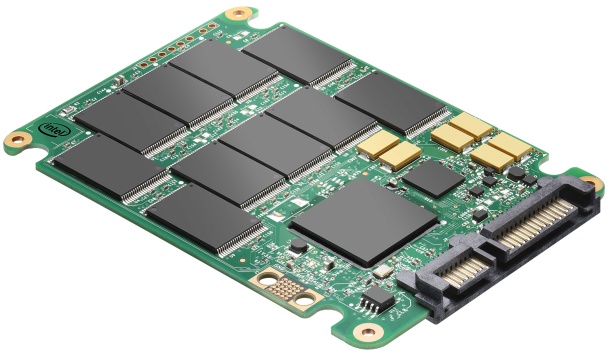Intel taps MLC for cheaper enterprise SSDs

Intel has introduced a range of solid-state drives based on 25nm multi-level cell flash, which replaces a line built on single-level cell technology as its key product for datacentres handling high input/output applications.

Intel has introduced the Solid-State Drive 710 series, based on 25nm multi-level cell (MLC) flash. Image credit: Intel
The Solid-State Drive 710 series is considerably more affordable than its predecessor, by virtue of using multi-level cell (MLC) flash rather than single-level cell (SLC) technology, the company said on Wednesday at the Intel Developer Forum in San Francisco.
MLC is typically cheaper than SLC, but not quite as fast, as the controller needs to search through multiple layers rather than a single one to fetch data.
"These drives significantly outperform rotating media," said Robert Crooke, the general manager of Intel's non-volatile memory solutions group. "This drive was architected and engineered for the datacentre."
The Sata 710 SSDs are aimed at enterprises that want to speed the performance of high input/output applications, such as online databases or business analytics. Intel said it expects companies involved in high-frequency trading, advanced visual rendering, and oil and gas exploration to be keen on the drives due to their combination of redundancy and speed.
The 25nm drives are available in 100GB, 200GB and 300GB versions and use a Sata 3Gbps interface. They are capable of up to 2,700 input/output operations per second (IOPS) for random writes and 38,500 for random reads, according to Intel.
This compares with 3,300 IOPS for writes and 35,000 for reads for its predecessor the X25-E SLC series (PDF), which launched in 2008 with a list price of around $718 (£455) for a 32GB version. The drives also compare favourably on reads with the 34nm X25-M Sata MLC series, which are capable of up to 8,600 IOPS for writes and 35,000 for reads.
A form of Raid-5 redundancy has been applied to the Nand flash arrays within the drives via firmware and controller technology, Intel said, which should increase redundancy in case of failures. There is also a feature called High Endurance Technology, which promises to extend the life of the drives through firmware changes. These changes help with error-correction code (ECC) and tweaks to the Nand flash.
Intel guarantees the drives for up to 1.5PB of writes over their lifetime. The drives should sell for around $649 (£411) for the 100GB version, $1,289 for 200GB and $1,929 for the 300GB, according to Intel.
The drives have begun shipping to Intel partners and hardware makers, so should begin appearing in equipment soon, Intel said, but did not give a specific date.
Get the latest technology news and analysis, blogs and reviews delivered directly to your inbox with ZDNet UK's newsletters.